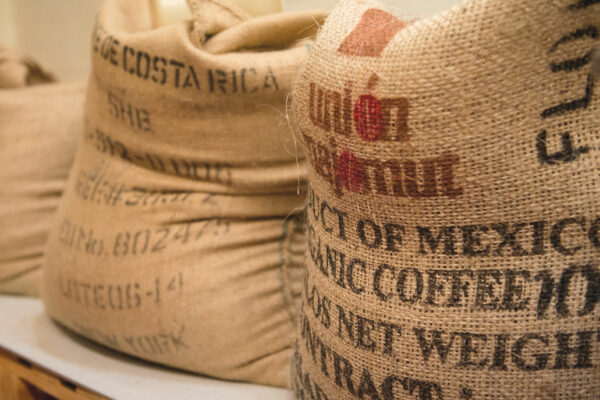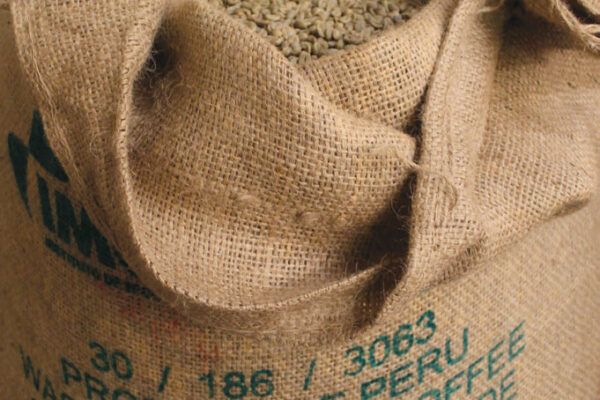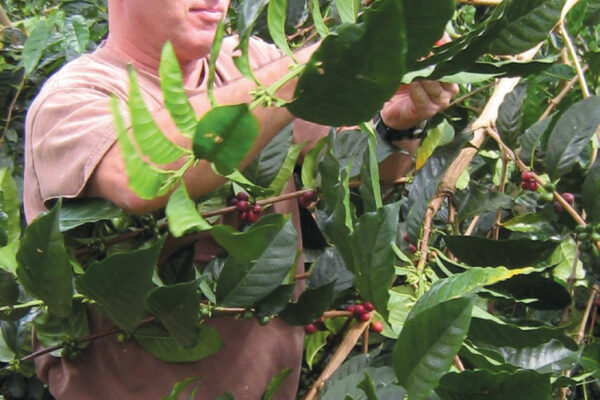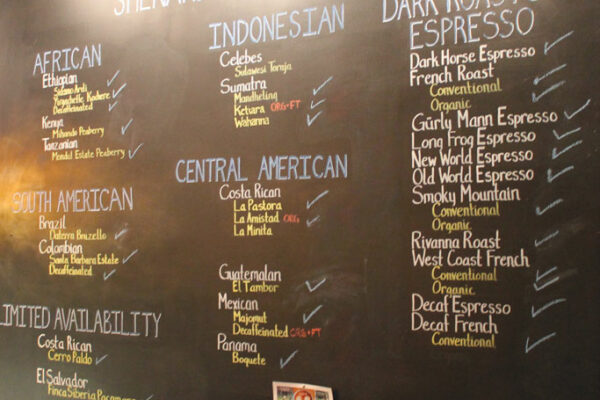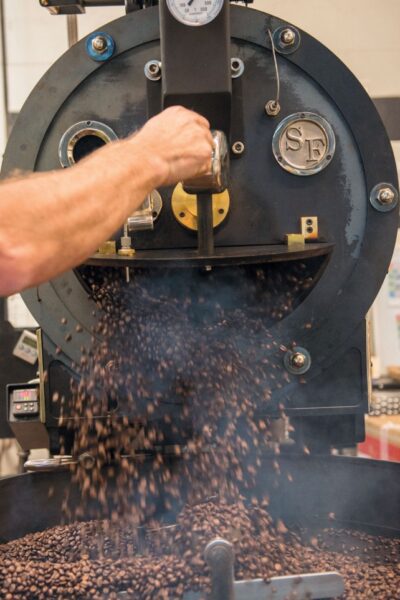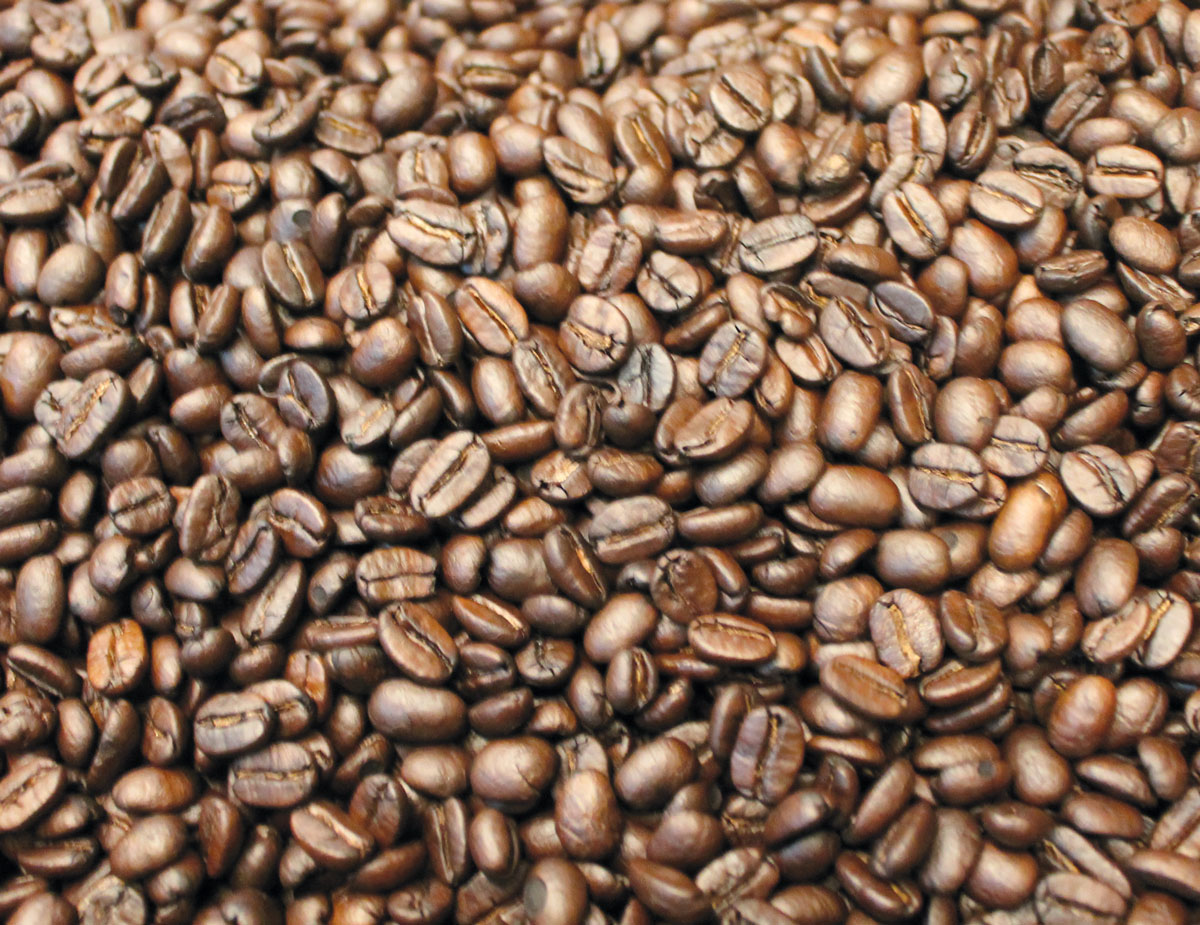
IT IS 4:15 A.M. IT IS COLD AND DARK. IT is raining. Normal people are still tucked into their warm beds, a couple of hours away from slapping the snooze buttons on their alarm clocks. Dave Fafara is not normal people.
Even at this ungodly hour, the “Dave Cave,” the garage-size space at the rear of Shenandoah Joe on Preston Avenue in Charlottesville, is already alive with light, an Allman Brothers song on Pandora, and—oh yes—the cobweb-clearing aroma of roasting coffee. For this is where Fafara does his thing, roasting every bean used by Shenandoah Joe’s three coffeehouse locations, plus a long list of local restaurant and retail clients.
“I haven’t used an alarm clock in 30 years,” Fafara cheerfully declares as he launches into the rhythms of a morning’s work, clad in a surf-shop T-shirt, khaki shorts, and canvas sneakers (no socks), despite the chilly weather. Yep, Fafara is also the kind of guy who makes cheerful declarations at 4:15 a.m.
Pallets stacked with 150-pound sacks dominate one side of the space. Bulging burlap bears stenciling that identifies the contents as products of coffee-growing lands including Mexico, Costa Rica, Guatemala, Honduras, Panama, Peru, Ethiopia, Kenya, Sumatra, and Java. Fafara first opens a sack from El Salvador and scoops 10 pounds of the green-gray beans into a bucket labeled “green organic only.” On the plant, these beans started as red, juicy “coffee cherries.” Once picked, they are fermented, dried, and milled to extract the raw beans that Fafara eventually receives.
Like most of the sacks, this one has a special, and even personal, origin story: A finca (farm)—named Siberia for its unpredictable weather and remote locale high in El Salvador’s mountains—produced only nine sacks of this particular variety.
“I have a buddy down there,” says Fafara, “so we split the order and got it all.” He perches on tiptoes to transfer the beans to the conical funnel that sits atop his roaster, where they spill down into the heated, rotating drum.
A word about this vital piece of equipment: Manufactured in Nevada, the San Franciscan model roaster strongly resembles a scale model of a vintage steam locomotive—especially when it occasionally belches a few puffs of smoke. Weighing in at 1,350 pounds, built of powder-coated steel, and able to handle 25-pound batches, it combines industrial utility and artisan craft in the hands of an attuned user.
“This roaster is a freaking workhorse,” Fafara says with unmasked affection. “They’re like the old VW Bugs, you can always get them running. I beat the crap out of this thing.”
At this moment, though, he is carefully monitoring a timer and a digital thermometer attached to the roaster. “The temperature of a smaller batch has a tendency to suddenly take off on you,” he explains. He sneaks a quick peek at a sample scooped from a miniature porthole in the roaster drum, then yanks a lever that releases the now dark, shiny beans into a circular bin equipped with a sweep arm to help them cool.
“I do everything based on time and temperature,” Fafara says as he immediately loads another batch into the roaster. “The whole process depends on me determining what looks and smells right. I’m using my senses.”
Indeed, it’s tempting to dub Fafara the “Coffee Whisperer”—except for the fact that whispering is contrary to every fiber of his being. Whether one encounters him manning the Shenandoah Joe booth at the Charlottesville farmers’ market, collecting toys as president of the local Toy Lift philanthropy, or sampling craft beers while listening to a band at Lockn’, he is always a ball of extroverted energy who raises the spirits of those around him. And that ain’t just the caffeine talking.
FAFARA WAS BORN AND RAISED near the stockyards on Chicago’s South Side, and still has the streetwise accent to prove it. Somewhat incongruous to that environment, he excelled on his high school diving team. “It was good for someone with a short attention span, and girls seemed to like it,” he says.
He also dove competitively in college, but had to quit and go to work after his father died. In the early ’80s, the Chicago boy moved to sunny California to coach diving at the high school and collegiate levels.
“When we were in California, we used to surf in the morning, then stop at a coffee shop,” he says. “That’s where my fascination with coffee started. I’d find myself thinking that I’d love to open up a coffee shop when I retire because I could surf in the morning, and then drink coffee and bullshit all day.”
Obviously, the surfing dreams took a hit when he and wife Kristi relocated to Charlottesville in 1988 for a job with UVA’s swimming and diving program. “After we moved here, I still was ordering coffee from California because there wasn’t a lot of good coffee in Charlottesville then,” he says.
But one Sunday morning in 2000, when he was perusing the newspaper classifieds (to “learn what’s really going on in a community”), Fafara spotted a local coffee business listed for sale. Its name was Shenandoah Joe. “I went to just take a look at it,” he says. “But I came back and told Kristi, ‘We’re gonna buy this company.’”
At the time, the operation consisted of just a small roaster, a few wholesale clients, and some odds and ends in an industrial space. One employee agreed to stay on long enough to teach the Fafaras the ropes.
The turning point came when they decided to set up as a vendor at City Market on Saturday mornings. “That got bigger and bigger, and then we started selling some retail bags from the warehouse,” Fafara recalls. “We also let people put money in a jar and pour a cup of coffee at the warehouse. Some people would put $20 in the jar on Monday and drink for the rest of the week. Whoever drank the last cup had to pick a roast and brew the next pot, that was the rule.”
With demand swelling, the Fafaras moved into their flagship coffeehouse on Preston Avenue in 2007, and have since opened satellite locations in Ivy and on the Corner. A fourth outpost is coming soon to Harrisonburg.
Photo 2: A fresh decanter of pour-over coffee.
Photo 3: An artful cup.
Photo 4: Bags ready for local delivery.
“ARE YOU READY FOR A CUP OF COFFEE YET?”
Fafara poses the question with a sly grin because he already knows the answer, just as he knows that the smell of roasting coffee being pumped from a vent pipe in Shenandoah Joe’s back wall will soon make the surrounding neighborhood crave a cup too.
It’s still too early for even the morning shift to be on duty, so after he loads the San Franciscan with a new batch, he hustles up front to use a grinder and a French press. The steaming mugs sit for a few moments after he pours. “It should cool down just a bit to drinkable temperature,” he advises, “to taste all the characteristics.”
What are those characteristics? He takes a sip. “A little red fruit, subtle chocolate, good mouthfeel.” The concept of terroir, the qualities of flavor imparted by the environment in which a food or beverage is produced, is every bit as important to coffee aficionados as it is to a wine-sniffing oenophile.
Fafara sidles back up to the roaster, where 25 pounds of Brazilian beans are being transformed into one of Shenandoah Joe’s signature coffees, Smoky Mountain. He times an espresso roast (longer than a light roast, shorter than a French roast), then closes the damper for 90 seconds so that the roast smoke sits on the beans. When he finally yanks the release lever, the beans spill out with a rush of smoke that tips off the nose to how this coffee will taste when cupped.
Truth told, Fafara treads softly on the French-roast end of the coffee continuum. “There are certain coffees you can dark roast and some you can’t or you kill those characteristics the coffee farmer worked so hard for,” he says. “It’s like cooking a good steak well-done. I will never take a single-origin coffee and burn it.”
One can safely assume, then, that such a fate won’t befall the particular beans that are Fafara’s current pride and joy, a crop from Honduras. He’s made good friends in various coffee-producing regions, and in turn, those friends know Fafara’s tastes. So it was that a Honduran coffee miller sent Fafara a sample of beans grown by a lone farmer named Marzo Muñoz. Using a small sample roaster that is an exact miniature of his big San Franciscan, Fafara conducted a test roast. “A sample roaster is a luxury, but it’s important to me,” he says. “And when I’m roasting a sample for the first time, I don’t want anyone near to distract me.” The results wowed him. The total crop was just 900 pounds, so Fafara bought every last bean.
His personal connection with growers doesn’t stop there. Every winter he travels to far-flung coffee-producing regions to meet them and participate in the harvest season. Last year he visited Honduras, El Salvador, Costa Rica, Panama, and Ethiopia. “That furthers my working relationship with those farmers, which helps me to continue getting their crop,” says Fafara, who refers to it as “relationship coffee.” This face-to-face style, favored by Fafara and other small, artisan coffee roasters, is nothing short of remarkable when you consider that coffee is the second-most-traded commodity in the world—behind oil.
Fafara has even sent roasted beans back to the very farmer who grew them in the first place. “These guys never get to drink their own coffee,” he says. “They put a lot of time and energy into growing a product for us up here, and I want them to experience what I’m doing with it.”
Of course, his top priority is sharing his craft with folks right here at home. “We try to teach our customers that each coffee doesn’t have to taste the same,” he says. “You wait in line for 20 minutes for a Chipotle burrito, you can wait in line four minutes for a good cup of coffee. I tell people to just wake up five minutes earlier.”
The sun is now up, and baristas out front are busy cupping an array of coffee preparations—drip, pour-over, French press, cappuccino, espresso, latte—to a steady stream of customers, while another staffer transfers fresh-roasted beans into paper bags labeled with the names of familiar restaurants such as C&O, Orzo, Rapture, and Red Pump Kitchen. Fafara has been roasting for hours already, and will continue for several more before he finishes 27 separate roasts totaling 650 pounds of coffee, a process he repeats several times a week. For the moment though, while he monitors a batch in progress, he’s also able to take stock of his role as one of the area’s foremost coffee gurus.
“You know you’re doing okay when you see the same people coming in every morning for a cup of coffee,” he says. “Truth is, I’m even more excited by coffee now than I was when I started. One day I’m gonna get a business card that says ‘Coffee Roaster and Legal Drug Dealer.’”

